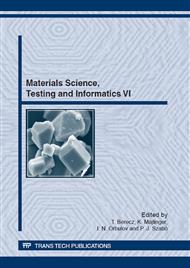[1]
R.Z. Valiev, T.G. Langdon, Principles of equal-channel angular pressing as a processing tool for grain refinement, Prog. Mater. Sci. 51 (2006) 881-981.
DOI: 10.1016/j.pmatsci.2006.02.003
Google Scholar
[2]
A.P. Zhilyaev, T.G. Langdon, Using high-pressure torsion for metal processing: Fundamentals and applications, Prog. Mater. Sci. 53 (2008) 893-979.
DOI: 10.1016/j.pmatsci.2008.03.002
Google Scholar
[3]
H.J. Choi, J.H. Shin, B.H. Min, J.S. Park, D.H. Bae, Reinforcing effects of carbon nanotubes in structural aluminum matrix nanocomposites, J. Mater. Res. 24 (2009) 2610-2616.
DOI: 10.1557/jmr.2009.0318
Google Scholar
[4]
H. Li, A. Misra, Y. Zhu, Z. Horita, C.C. Koch, T.G. Holesinger, Processing and characterization of nanostructured Cu-carbon nanotube composites, Mater. Sci. Eng. A 523 (2009) 60-64.
DOI: 10.1016/j.msea.2009.05.031
Google Scholar
[5]
G. Ribárik, J. Gubicza, T. Ungár, Correlation between strength and microstructure of ball-milled Al–Mg alloys determined by X-ray diffraction, Mater. Sci. Eng. A 387–389 (2004) 343-347.
DOI: 10.1016/j.msea.2004.01.089
Google Scholar
[6]
L. Balogh, G. Ribárik, T. Ungár, Stacking Faults and Twin Boundaries in fcc Crystals Determined by X-ray Diffraction Profile Analysis, J. Appl. Phys. 100 (2006) 023512.
DOI: 10.1063/1.2216195
Google Scholar
[7]
P. Jenei, E.Y. Yoon, J. Gubicza, H.S. Kim, J.L. Lábár, T. Ungár, Microstructure and hardness of copper–carbon nanotube composites consolidated by High Pressure Torsion, Mater. Sci. Eng. A 528 (2011) 4690-4695.
DOI: 10.1016/j.msea.2011.02.066
Google Scholar
[8]
J. Luo, R. Stevens, Porosity-dependence of elastic moduli and hardness of 3Y-TZP ceramics, Ceram. Int. 25 (1999) 281-286.
DOI: 10.1016/s0272-8842(98)00037-6
Google Scholar
[9]
N.Q. Chinh, J. Gubicza, T.G. Langdon, Characteristics of face-centered cubic metals processed by equal-channel angular pressing, J. Mater. Sci. 42 (2007) 1594-1605.
DOI: 10.1007/s10853-006-0900-3
Google Scholar
[10]
J. Gubicza, N.Q. Chinh, J.L. Lábár, Z. Hegedűs, C. Xu, T.G. Langdon, Microstructure and yield strength of severely deformed silver, Scr. Mater. 58 (2008) 775-778.
DOI: 10.1016/j.scriptamat.2007.12.028
Google Scholar
[11]
D.H. Chung, W.R. Buessem, in: F.W. Vahldiek, S.A. Mersol (Eds. ), Anisotropy of Single Crystal Refractory Compounds, vol. 2, Plenum Press, New York, 1968, pp.217-245.
Google Scholar
[12]
N. Hansen, Hall–Petch relation and boundary strengthening, Scr. Mater. 51 (2004) 801-806.
DOI: 10.1016/j.scriptamat.2004.06.002
Google Scholar
[13]
D.A. Hughes, N. Hansen, Microstructure and strength of nickel at large strains, Acta Mater. 48 (2000) 2985-3004.
DOI: 10.1016/s1359-6454(00)00082-3
Google Scholar
[14]
T. Tokunaga, K. Kaneko, Z. Horita, Production of aluminum-matrix carbon nanotube composite using high pressure torsion, Mater. Sci. Eng. A 490 (2008) 300-304.
DOI: 10.1016/j.msea.2008.02.022
Google Scholar


